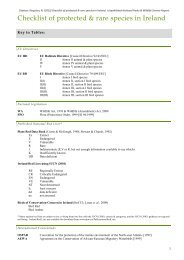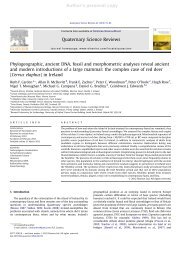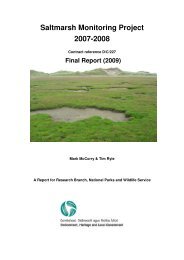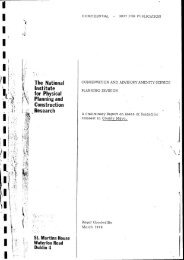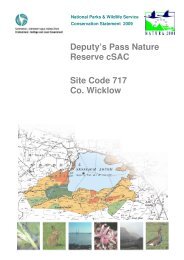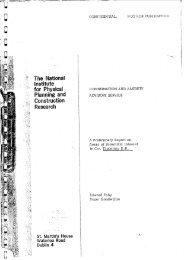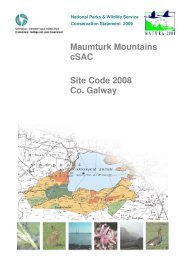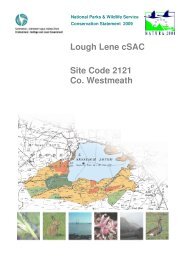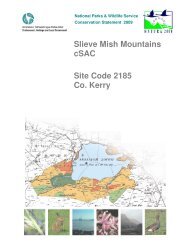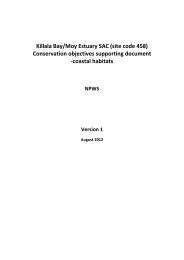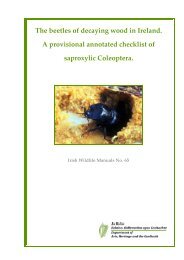The Role of Kelp in the Marine Environment - National Parks ...
The Role of Kelp in the Marine Environment - National Parks ...
The Role of Kelp in the Marine Environment - National Parks ...
You also want an ePaper? Increase the reach of your titles
YUMPU automatically turns print PDFs into web optimized ePapers that Google loves.
numbers at <strong>the</strong> same sites (Arzel, 2000). As competition between L. digitata and S.<br />
polyschides is known to occur, <strong>the</strong> question to be answered is whe<strong>the</strong>r L. digitata is <strong>in</strong><br />
decl<strong>in</strong>e, thus <strong>of</strong>fer<strong>in</strong>g more space for Sacchoriza colonization or whe<strong>the</strong>r L. digitata is<br />
be<strong>in</strong>g actively displaced by S. polyschides competition.<br />
Several explanations are under <strong>in</strong>vestigation (Arzel, 2000):<br />
� <strong>the</strong> exploitation method : successive modification <strong>of</strong> <strong>the</strong> harvest<strong>in</strong>g tool have<br />
resulted <strong>in</strong> more stipes be<strong>in</strong>g left on <strong>the</strong> substrate than previously.<br />
� <strong>the</strong> Sacchoriza life cycle is shorter than that <strong>of</strong> L. digitata, thus favour<strong>in</strong>g <strong>the</strong><br />
former, on a substratum already open to recruitment by <strong>in</strong>tensive cutt<strong>in</strong>g, much as<br />
L. digitata displaced L. hyperborea <strong>in</strong> <strong>the</strong> case already discussed.<br />
� 10% <strong>of</strong> <strong>the</strong> boulders are turned upside down dur<strong>in</strong>g harvest<strong>in</strong>g, result<strong>in</strong>g <strong>in</strong> fast<br />
colonization <strong>of</strong> <strong>the</strong> blank face by opportunistic fast-grow<strong>in</strong>g Chlorophyceae, <strong>the</strong>n<br />
by S. polyschides.<br />
� <strong>the</strong> abrasive effect <strong>of</strong> sand is an <strong>in</strong>direct effect <strong>of</strong> substrate loss. Abrasion is lethal<br />
to Lam<strong>in</strong>ariales gametophytes and young sporophytes.<br />
� climatic events: <strong>the</strong> frequency <strong>of</strong> major storms has <strong>in</strong>creased over <strong>the</strong> last decade<br />
with direct effect on kelp beds : plants are torn away and more sand abrasion<br />
occurs.<br />
� water temperature : an <strong>in</strong>crease <strong>in</strong> temperature has been documented <strong>in</strong> Brittany<br />
which is at <strong>the</strong> sou<strong>the</strong>rn limit for L. digitata. <strong>The</strong> upper temperature for L.<br />
digitata is 20°C and <strong>in</strong> Brittany this can be reached <strong>in</strong> summer. Sacchoriza is<br />
more temperature tolerant and is distributed down to northwest coasts <strong>of</strong> Africa.<br />
� photo-<strong>in</strong>hibition from U.V radiation is <strong>of</strong>ten lethal to sporophytes and especially<br />
on gametophytes. This factor may harm L. digitata dur<strong>in</strong>g summer especially on<br />
<strong>the</strong> younger <strong>in</strong>dividuals after harvest<strong>in</strong>g <strong>of</strong> most <strong>of</strong> <strong>the</strong> protective canopy.<br />
� pollution.<br />
It is clear that unforeseen changes <strong>in</strong> species composition are associated with<br />
<strong>in</strong>tensive harvest<strong>in</strong>g <strong>of</strong> <strong>the</strong> kelp resource. <strong>The</strong>re appears to be a tendency for short<br />
lived species to replace long lived species. This tendency must result <strong>in</strong> <strong>the</strong> reduction<br />
<strong>of</strong> populations <strong>of</strong> L. hyperborea, when <strong>in</strong>tensively harvested.<br />
48



